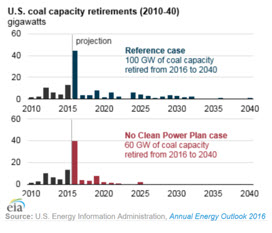Regardless of CPP, more coal plants headed to retirement
WASHINGTON,
May 26, 2016 - Significant coal retirements are expected to continue regardless
of whether the Obama administration’s Clean Power Plan (CPP) is finally
implemented. However, carbon dioxide (CO2) emissions trends from electricity
generation through 2040 depend significantly on whether
or not the CPP rule issued last August by the EPA is implemented.
At
least that’s the perspective from two potential scenarios analyzed in the Energy Information Administration’s (EIA’s) Annual
Energy Outlook 2016 (AEO2016).
The
“Reference case” assumes implementation of EPA's final CPP rule, while the “No
CPP” case assumes the rule, enforcement
of which is currently on hold pending judicial review, is not implemented.
The
power sector currently accounts for 36 percent of total energy-related CO2
emissions, EIA says, but its share falls to 31 percent by 2030 in the Reference
case, when power sector emissions fall below those of the transportation sector.
 In
the No CPP case, the analysis finds that the power sector emissions remain near
36 percent of total energy-related CO2 emissions throughout the projection
period.
In
the No CPP case, the analysis finds that the power sector emissions remain near
36 percent of total energy-related CO2 emissions throughout the projection
period.
The
EIA notes that other CPP-related scenarios, to be released over the coming weeks,
will include different implementation alternatives. Some results, such as
electricity prices and the mix of fuels used to generate electricity, are
likely to depend significantly on compliance strategies, says EIA.
Coal
plant retirements have been relatively high in recent years—nearly 14 gigawatts
(GW) in 2015—because of an increase in competition from units burning
low-priced natural gas and the implementation of environmental regulations.
About
three times the amount of coal retirements in 2015 are expected to occur in
2016—40 GW to 45 GW—as the final deadline for the EPA's Mercury and Air Toxics Standards
(MATS) occurred in April of this year, the analysis notes. After 2016, another
55 GW of coal plants retire by 2040 in the Reference case as the Clean Power
Plan is adopted. Even in the No CPP case, about 20 GW of coal-fired capacity
retires from 2017 through 2040.
#30
For
more news, go to: www.Agri-Pulse.com
